Life Goes On- Centre-DePauw, November 6, 1920
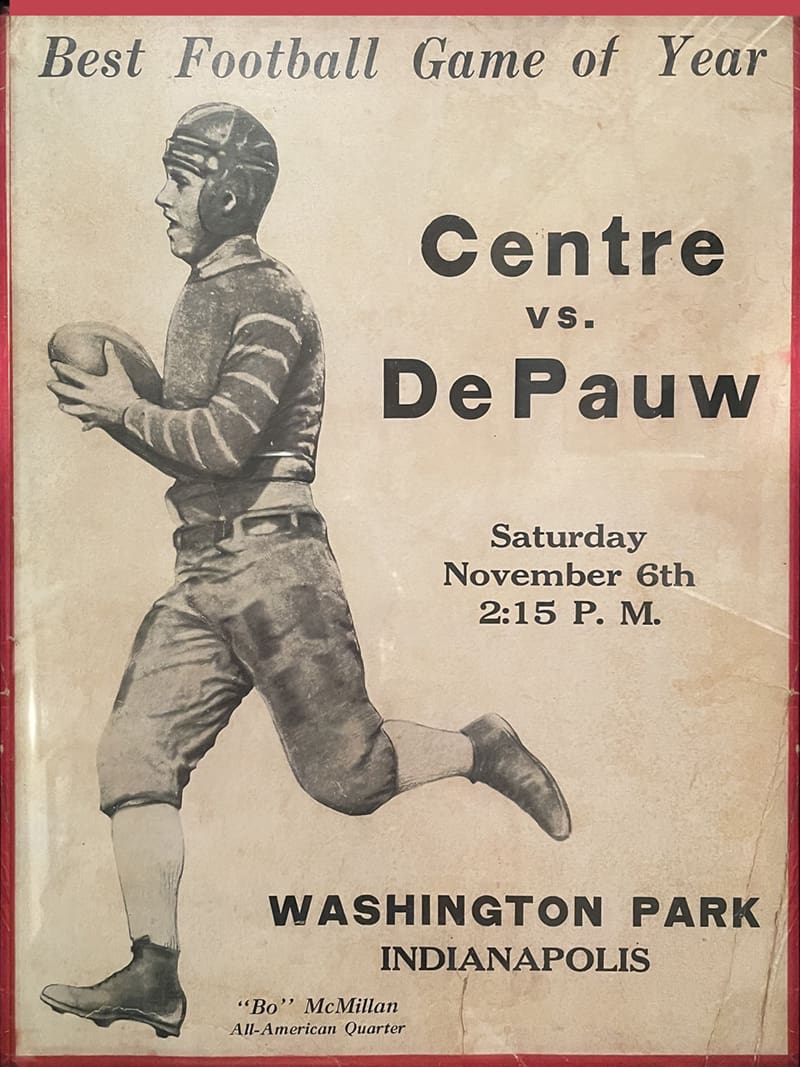
An interesting tidbit appeared in the Danville "Advocate" on November 2, ten days after the Harvard game.
Mr. and Mrs. Rufus Lipps have returned from Boston, Massachusetts. They saw the Old Centre and Harvard football game. Mr. Lipps states they made the entire trip in a Ford automobile and did not have a single puncture and that it was not necessary on a single occasion to even add additional inflation to a tire. ( More about a Ford and tire in Chapter 100 )
Meanwhile, there was a football season to complete after the debacle in Atlanta. DePauw, Kentucky, Virginia Tech and Georgetown (Ky.) remained on the schedule, with only Georgetown being a home game.
Once again, Uncle Charlie and his trainers used the Monday after returning to Danville to evaluate the players who were still suffering from the injuries sustained at Harvard and the many new ones received during the Georgia Tech game.
Bo felt that the team had reached a critical juncture and used the day off from practice to call a late afternoon team meeting held in the Boyle-Humphrey gym. He knew that his squad was down both physically and mentally. The injuries would heal. What he wanted to make certain was that the emotional state of his teammates wouldn't hamper the rest of the season. The team needed bucking up.
It was a meeting that only a team captain, and only a player as well respected as Bo, could conduct.
Bo recounted the events of the last two weeks and how great teams and great players bounce back from adversity. Over and over he reminded his teammates that, "We are Centre!"
Bo said that if the Colonels won the last four games, the season could still be a success. He told the team that now was the time that separated the men from the boys, that separated those who would be winners in life from those who would be mere spectators.
"It's easy to be on top, when everything is going good. But the test of the man is to come back when he's been dealt a blow. Will you roll over, or will you work even harder and show what type of character you have?"
My brother Howard was at Centre, and he was on the team as a scrub in 1920. He didn't even suit up for games, but he practiced and he knew what was going on. Howard happened to be in the gym when Bo called the meeting after the loss to Georgia Tech. He said the most amazing thing happened.
Bo kept repeating, over and over, "We are Centre! We are Centre!"
And then, one by one, the players began to join in.
"We are Centre! We are Centre!"
Pretty soon, they were all on their feet yelling, "We are Centre! We are Centre!"
It just went on and on.
"We are Centre! We are Centre!"
"We are Centre! We are Centre!"
"We are Centre! We are Centre!"
Howard said that whatever doubts the team may have had after the two tough losses just disappeared. The team walked out of that meeting more convinced than ever that they had a great destiny, and they were going to fulfill their dreams, and soon they began talking about playing Harvard the next year.
DePauw in Indianapolis was next, with the game to be played on November 6.
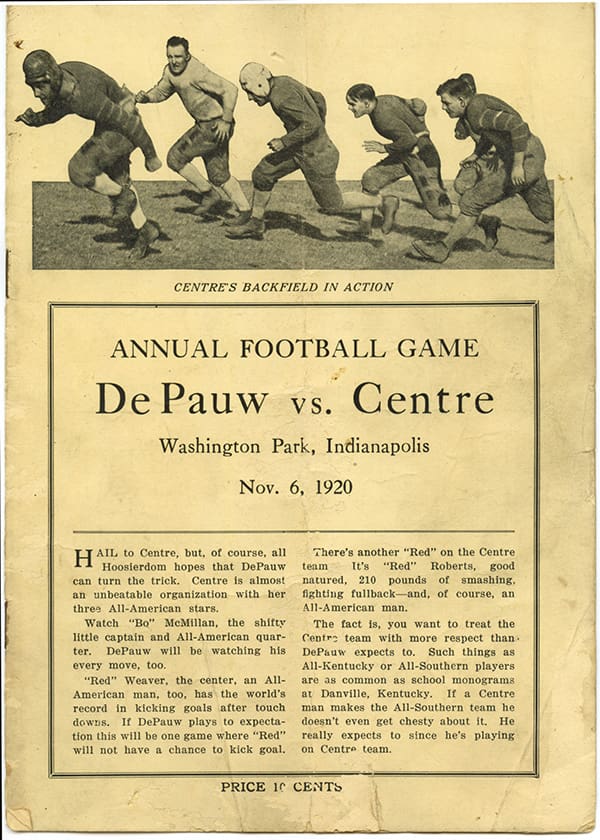
The write-up on the cover of the program for the DePauw game featured Centre's 3 All-Americans from 1919-Bo McMillin, Red Weaver, and Red Roberts. It isn't certain that the picture of the "backfield" is even Centre players. However, it is obvious that DePauw put a lot of effort into organizing the game from the extensive number of individuals listed in the insert of the program below as there are 56 people listed.
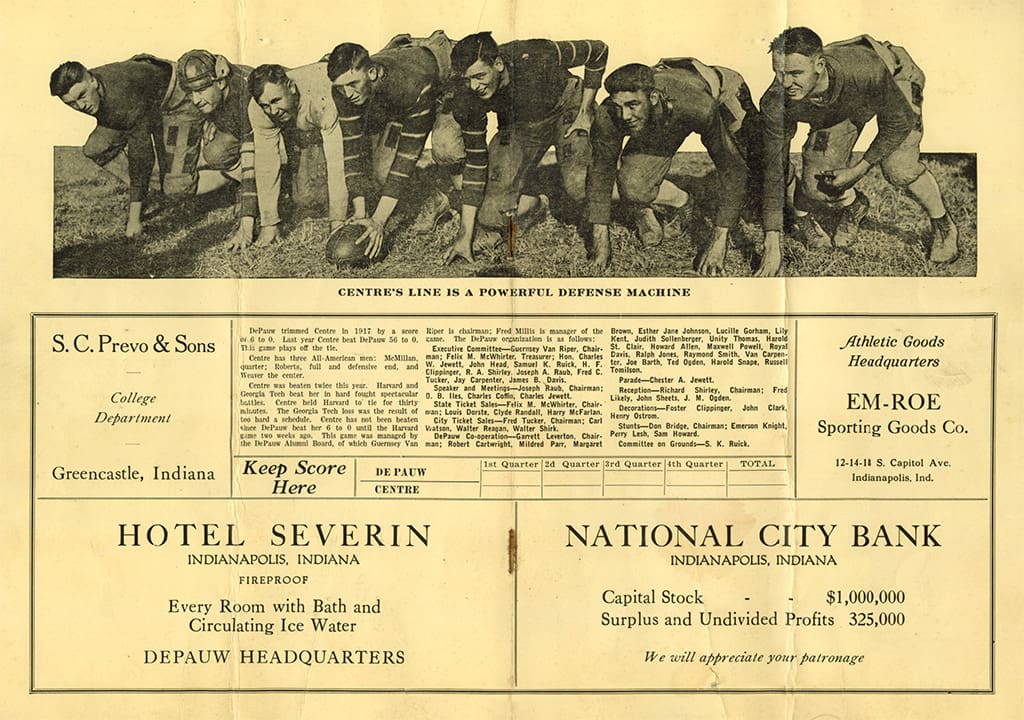
Quite a strange group of "a powerful defense machine." The only players for certain who can be identified are Army Armstrong at the right end position and Ben Cregor next to him at right tackle with Shanks Lipscomb over the ball at center. Armstrong never played end in all of his years at Centre. The other players certainly weren't starters and it isn't know how this photo was produced. Red Roberts is probably at left end. The Hotel Severin was the site of the banquet after the game.
During the 1919 game between the two schools in Louisville, the Tigers had been handled easily by the Colonels who won 55-0. Uncle Charlie reminded the team that DePauw could be tougher than expected.
His reasoning was based on the Harvard-Valparaiso game of October 9. Harvard won 21-0. DePauw and Valpo had been tied 0-0 in the fourth quarter of their game on October 29 when there was a disputed play and Valparaiso walked off the field in protest. ( DePauw was declared the winner by forfeit, and the game is listed in the records as DePauw 1- Valparaiso 0.)
"So that means that DePauw and Valpo are basically equal. They were tied, and Harvard scored 10 less points, 21, against Valpo, than they did against us."
The players had to think about that for a moment. It was somewhat of a convoluted type of reasoning, but Moran's point was well taken.
"We've got to take this team seriously, especially because we still have a lot of injuries."
Indianapolis certainly was taking the game seriously. DePauw was having a good year, winning four straight after losing their opener against Purdue, 10-0. Centre was Centre, and everyone was anxious to see what was still being referred to as the "Wonder Team," despite the loss of the last two games.
The highway from Greencastle, Indiana to Indianapolis was poor, and DePauw secured a special "Big Four" day train to take 1,000 students to the game on the Vandalia Line, even though the distance was only approximately 40 miles.
The school newspaper, "The DePauw," had built up the game with articles about the Colonels accompanied by photographs of Red Roberts and Bo.
The editor of "The DePauw" arranged for an article to be sent from Centre's school paper, the "Cento," containing the Centre viewpoint of the upcoming game.
Walter Brashear, the "Cento's" editor, wrote that Centre looked forward to the contest in Indianapolis, and somewhat undiplomatically reminded the readers that Centre had won by a decisive 56-0 margin the previous year. However, Brashear did point out that DePauw had beaten the Colonels in 1917, the last loss prior to the Harvard and Georgia Tech defeats.
During the week, Uncle Charlie again didn't let the team have any contact. They mainly jogged and worked on their timing. One diversion was when the team went to the Colonial movie theater on Main Street to watch films of the Harvard game which were being shown all over the country. M.G. Weisinger, the theater manager, roped off the front two rows with gold ribbons and invited the Colonels to watch not only the scenes from Harvard Stadium, but the featured film, "The Lone Wolf's Daughter," starring Louise Glaum.
The audience stood and cheered for several minutes when the players came into the theater. When the lights went out, they were thrilled by the coverage of the game.
There were several shots of the fans filing into the stadium, a panning inside the big horseshoe of the capacity crowd, and several series of plays on the field were shown, including Red Roberts scoring and Lefty Whitnell hauling in Bo's long pass for the second touchdown.
Whistles, clapping, and foot stomping seemed like they'd never let up as Lefty crossed the goal.
The theater resonated with the crowd chanting, "Lefty, Lefty, Lefty," until the Centre star stood and took a bow.
The films were shown in Boston at a downtown theater, and a reviewer wrote that, "The photography is excellent and there are plenty of scenes which make this great viewing."
( I went to Boston and Harvard in 2007 and searched for the films and for any that may exist for the later games in 1921 and 1922 but could find no evidence of them, and my researcher, Tony Gaier, couldn't locate them either despite a major effort. )
Centre left for Indianapolis at 5:35 Friday afternoon, traveling through Lexington and Cincinnati. The team's overnight journey found them arriving at their destination at 7:00 A.M., Saturday, the day of the game.
As the Colonels were transported to the Claypool Hotel, they were impressed by the extensive preparations which had taken place in the city for the game. The entire area was decorated in the gold and white of Centre, and the gold and black of DePauw.
In the lounge of the Claypool, Indianapolis Mayor Charles R. Jewett and representatives of DePauw formed a reception line and shook the hands of the Colonels as they filed into the big reception room.
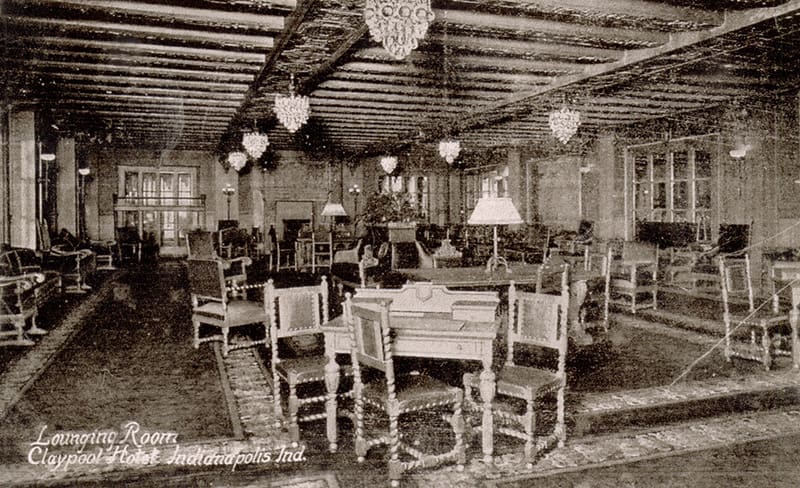
The lounge in the Claypool where the team was greeted upon arrival in Indianapolis
Mayor Jewett then read a proclamation in which he declared the day, "Gold Day," in honor of both school's colors.
Photographs were taken, interviews conducted, and then the Colonels retired to the dining room for breakfast, after which they strolled around downtown Indianapolis prior to heading to Washington Park for the game.
The Indianapolis "News" had provided significant coverage for the upcoming game and published a photo about the "Praying Colonels" playing in the city. It was apparent with the inclusion of "Shanks" Lipscomb at the center position that it was aware that Red Weaver wasn't going to be available for the game due to his injuries still being felt from the Harvard game.

Army Armstrong and Bo were fit to play in the Depauw game. Red Roberts was still hobbled and Red Weaver was replaced by Shanks Lipscomb but still could kick extra points.
Uncle Charlie had to scrape together a lineup. He took 25 men to the game, and hoped to play most of them, saving his team for the following week's important game with Kentucky.
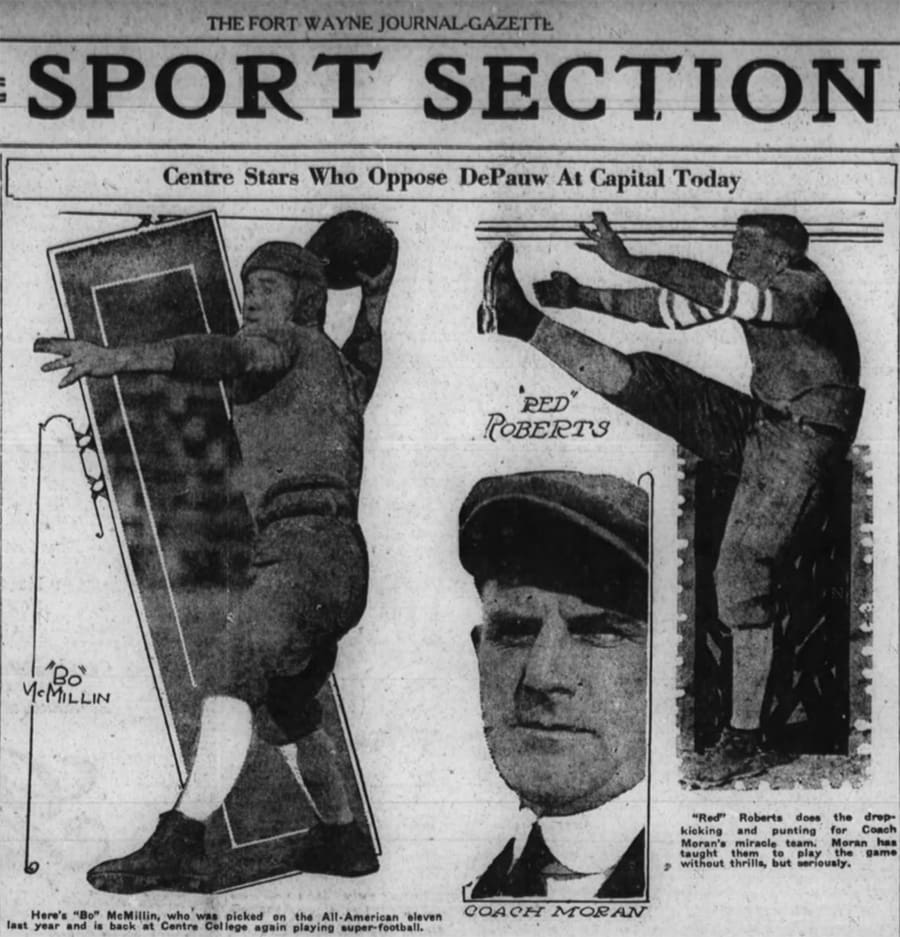
Bo was able to play but Uncle Charlie knew that Red Roberts wasn't ready for any contact.
Stanley Robb was penciled in at fullback. Not only was Red Roberts still hobbled, but Hump Tanner, who started in the Tech game, had taken such a beating that he was also going to ride the bench, at least at the start.
Lefty Whitnell was to be replaced by Tom Moran, and Uncle Charlie planned to give Ashley Blevins, who only weighed 158 lbs., considerable time in the line in order to spell Bill James and Ben Cregor.
Centre entered Washington Park to a huge ovation. The facility held 16,000, and an additional thousand standing room tickets had been sold.

Washington Park, site of the 1920 Centre-DePauw game in Indianapolis
With the 45,000 plus at the Harvard game, 20,000-25,000 in Atlanta, and the crowd of 17,000 in Indianapolis, it meant that the Colonels would have played in front of somewhere around 85,000 fans the past three weeks!
The Centre College Colonels could generate more excitement and interest than any team in the country, and the games which sold out everywhere they played certainly attested to that fact.
Centre got back on track in Indianapolis. The first quarter was scoreless, but the Colonels racked up 6 first downs. DePauw didn't get one.
In the second quarter, Lefty Whitnell came in for Tom Moran, carried for 24 yards on two wide, end-sweeps, and Bo took it in from the 23. Red Weaver could still kick and made it 7-0.
Later in the quarter, Bo ran for 24, threw a 30-yarder to Terry Snowday, and had the ball on the DePauw 15 but couldn't move it over the goal, so he kicked a field goal and it was 10-0 at the half.
Army had played well, running once for 30 yards and hauling in a pass for similar yardage. Bill James and Ben Cregor led the defense in shutting down DePauw's attack.
The Colonels offense looked like its old self in the second half. Bo intercepted a pass and ran the ball back for 15 yards, then gained 18 around end, hit Terry Snowday on a 20-yard pass, and Terry stiff-armed and faked and twisted down the field through 5 defenders for another 22 yards and scored. Weaver kicked number 74 to put the Colonels up, 17-0.
Hump got into the game and Bo called his number four straight times and the coal-haired fireplug picked up 30 yards. Bo hit Jack Converse for 20, and then Army plunged over from 7 yards out. Red Weaver's 75th naturally, made it 24-0 as the 3rd quarter ended.
Later, Tom Bartlett moved to the fullback position and scored from the 24, Bo hit the extra point as Red Weaver's knees were stiffening. Bo booted a 17-yard field goal, and the Colonels walked off the field with a very workman-like, 34-0 victory.
Uncle Charlie put Red Roberts in for a few plays near the end of the game after the crowd had begun to chant his name. The big guy got a standing ovation, stayed in for a couple of plays in the line, and received an even greater cheer when he trotted back off the field, waving and smiling at the appreciative fans.
An Indianapolis "Star" reporter provided a laudatory account of Bo's performance at the game.
Bo McMillin, heralded as the greatest quarterback of the day, stood out like a beacon light on a rocky coast. He hurled forward passes like a Gipp, skirted the ends like a Harley, and even bettered the best performance Harley ever showed as an open-field runner. Time after time, McMillin started his run around his left end, only to end up far on the right wing, after darting back and forth, straight-arming would-be DePauw tacklers. Whenever it was necessary for a first down, McMillin was good for the mark.
( Charles W. "Chic" Harley was a standout back for Ohio State on the 1916, 1917 and 1919 teams. He was a Walter Camp, first team All-American on the same 1919 team as Bo and Red Weaver. George Gipp was a Notre Dame star who was placed on Camp's first team in 1920 and died after the season on December 14. He was immortalized by Notre Dame's coach, Knute Rockne, who implored his team, at the half of the 1928 Army game, to "win one for the Gipper." The Irish scored twice in the second half to upset the Cadets, 12-6. )
After the game, the DePauw alumni association hosted a banquet at the city's finest, the Severin Hotel, a luxurious, brick, high-rise built seven years earlier at 40 West Jackson. Mayor Jewett praised the clean play of both teams, and everyone at the event who was familiar with what had transpired in Atlanta was gratified that Indianapolis and DePauw had stepped up and displayed the sportsmanship which Centre had become both known for, and to which the Colonels were accustomed.

The Beaux-Arts-style Hotel Severin, built in 1913, was the finest hotel in Indianapolis when built. It still stands at 40 West Jackson Place and is now the Omni Severin Hotel after a $40 million renovation restored it to its historical elegance.

Louis XIV Cafe, site of the post-game banquet
After the banquet, the Kentuckians returned to the Claypool for a dance hosted by DePauw's Delta Tau Delta fraternity, and it was late before the Colonels retired upstairs to their rooms, with even the sore-legged two Reds taking part in some of the less lively dances.
An article written the weekend of the game concluded by stating:
It was indeed a great day for the Colonels and they can only hope that next year they can in some degree extend the same welcome and same courtesies to the gentlemen of DePauw. Games of Saturday's caliber may be termed jewels in gridiron history where the teams throw aside sectional differences and meet on the same level with only one idea in mind-to play their best and give the victor his due.

Despite plans for a 3rd Centre-DePauw game for 1921, it didn't occur. See Chapter 60 for an explanation.
